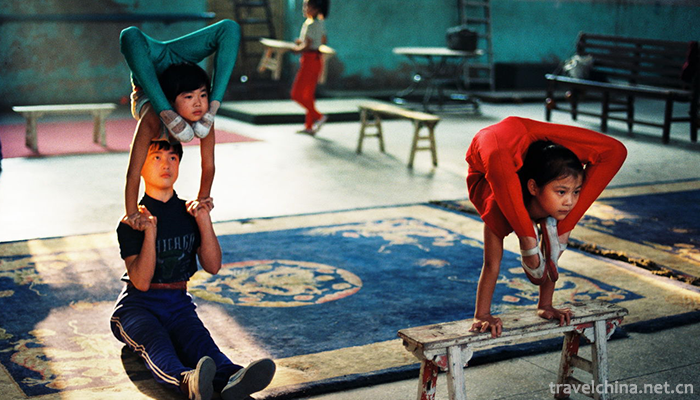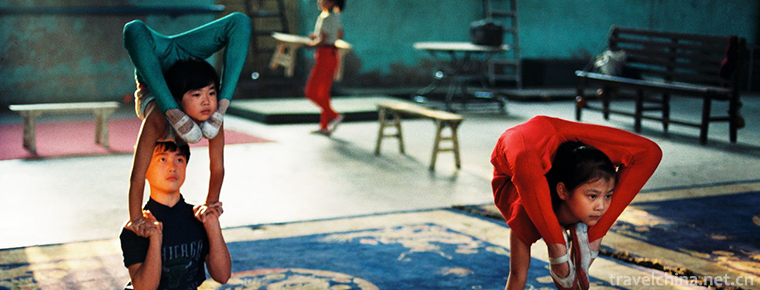Liaocheng acrobatics
Liaocheng acrobatics
Liaocheng acrobatics is a traditional folk acrobatics art in Shandong Province. Liaocheng is one of the birthplaces of Chinese acrobatics. In the late Neolithic period, Liaocheng was the main area where the Dongyi people lived. At that time, Chiyou, the leader of the Dongyi people, was said to be a master of acrobatics. Ancient acrobatics originated from Jiao Dai, or Chiyou Opera. Liaocheng acrobatics is now distributed in Donga, Chiping, Yanggu and other counties and their surrounding areas. During the Spring and Autumn Period and the Warring States Period, the Acrobatic Circus in Liaocheng was initially developed and had basically matured in the Han Dynasty. During the Three Kingdoms Period, acrobatics circus was very popular in Donga area of Liaocheng, and became a form of performance with acrobatics as the main part and other skills. Cao Zhi, the king of Donga, once described this situation with the poem "cock fighting in the eastern suburbs, horse walking between catalpa trees". Historically, the Yellow River was flooded with disasters. Many farmers had to abandon agronomy in order to survive. Mengzhuang, Hezhuang and Zhang Darenji villages in Donga County were famous acrobatic villages.
On May 20, 2006, the heritage was approved by the State Council and listed in the first batch of national intangible cultural heritage list.
Liaocheng acrobatics
Liaocheng is one of the birthplaces of Chinese acrobatics. In the late Neolithic period, Liaocheng was the main area for the activities of the Dongyi people. Chiyou, the leader of the Dongyi people at that time, was said to be a master of acrobatics. Ancient acrobatics originated from Jiao Dai, or Chiyou Opera. Liaocheng acrobatics is now distributed in Donga, Chiping, Yanggu and other counties and their surrounding areas.
During the Spring and Autumn Period and the Warring States Period, the Acrobatic Circus in Liaocheng was initially developed and had basically matured in the Han Dynasty. During the Three Kingdoms Period, acrobatics circus was very popular in Liaocheng's Donga area, and became a form of performance with acrobatics as the main part and other skills. Cao Zhi, the king of Donga, once described this situation with the poem "cock fighting in the eastern suburbs, horse walking between catalpa trees". Historically, the Yellow River was flooded with disasters. Many farmers had to abandon agronomy in order to survive. Mengzhuang, Hezhuang and Zhang Darenji villages in Donga County were famous acrobatic villages. In the early Republic of China, there were dozens of Acrobatic Circus troupes in Donga County alone. In addition, there are dozens of acrobatic troupes in Yanggu, Siping, Shenxian and Linqing. Some of them have performed in Korea, Japan and Singapore. In 1955, eight circuses were formally organized in Donga County. In 1970, Liaocheng Acrobatic Troupe was established.
Liaocheng acrobatics has a long history, with a large number of artists, and gradually formed a cultural system of acrobatics industry with Qilu characteristics. Liaocheng acrobatics mainly includes circus, magic and performance. It attaches great importance to waist and leg performance, highlights new, difficult, strange, beautiful and dangerous artistic style, simple, heroic and rugged, known as Qilu Yinghao, and is loved by the masses.
At present, although Liaocheng acrobatics has been vigorously explored and advocated, there is still a declining trend. This is mainly because with the improvement of living standards, acrobatics as a means of livelihood has become unattractive to today's young people, resulting in a serious succession of no one phenomenon. Some accomplished acrobats have gradually withdrawn from the stage because of their advanced age, and some have died one after another, making some stunts face the danger of losing their heritage.
In 1993, the Ministry of Culture approved the establishment of a Chinese juvenile acrobatics base in Liaocheng, and included it in the Dandelion Plan of the State Council. The Liaocheng government has established the Dandelion Acrobatic Art School in Liaocheng, relying on the Chinese Children's Acrobatic Base, to train the reserve talents of acrobatics. However, it is still far away from the scientific, three-dimensional, comprehensive and original ecological protection, and the consciousness and efforts of rescue and protection of intangible heritage need to be further strengthened.


-
1.Kunming World Horticultural Expo Garden
Kunming World Horticulture Expo Garden (hereinafter referred to as the World Horticulture Expo Garden) is the site of the 1999 Kunming World Horticulture Expo.
Time 2018-12-12 -
2.Green Island Tourist Villa
Green Island Tourist Villa is one of the eight new scenic spots in Chaozhou, the national demonstration sites of leisure agriculture and rural tourism, the base of science and technology
Time 2019-02-06 -
3.Rolling lamp
Rolling lantern is an art form of entertainment and self-enjoyment for the masses in Han folk festivals, and also a competitive performance to show the strength of villages. It is mainly prevalent in
Time 2019-05-02 -
4.Haizi Opera
Hezi Opera is one of the traditional operas in Anhui Province. It was named after the pronunciation of the word "sea". It is popular in some areas of Anhui and Henan
Time 2019-05-03 -
5.Lake Opera
Huzhou Tanhuang, originally known as Huzhou Tanhuang, is a traditional local opera. It is mainly popular in Huzhou, Jiaxing, Yuhang and Linan of Hangzhou, Wujiang and Yixing of Jiangsu, Guangde of Anh
Time 2019-05-03 -
6.Brewing Techniques of Old Vinegar
Qingxu old vinegar brewing skills, Shanxi Province Qingxu County local traditional skills, one of the national intangible cultural heritage.
Time 2019-05-11 -
7.Andai Dance of Mongolian Nationality
Andai Dance originated from the Kulun Banner. According to textual research, Andai Dance was formed in the late Ming and early Qing Dynasty. At that time, the Kulun system was "the unity of polit
Time 2019-06-03 -
8.Jockey Club
The horse race held every June in the Tibetan calendar is a grand traditional festival in the northern Tibetan grassland, also known as the "Grassland Festival", which lasts from 5 to 15 day
Time 2019-06-12 -
9.The game of go
Go is a strategic two-player game. It was called "game" in ancient China and "Go" in the West. Popular in East Asian countries (China, Japan, Korea, Korea), is one of the four arts
Time 2019-06-26 -
10.Yamugou scenic spot
Yamugou scenic spot is located on the Bank of Taiping River (a famous scenic spot in Guizhou Province) in Jiangkou County, Tongren City, Guizhou Province, adjacent to Fanjing Mountain (National Nature Reserve, China's top ten famous summer resort).
Time 2020-10-13 -
11.Cheongsam production technology
Most of the classical flag dresses have straight lines. The body is loose and the two sides are split. The bust and waist circumference are close to the size of the dress. The appearance of cheongsam is generally required to have all or part of the following characteristics:
Time 2020-12-11 -
12.Guangyuan primary industry
In 2018, the annual grain sown area in Guangyuan City was 311300 hectares, down 0.5% from the previous year. The total grain output was 1.5641 million tons, down 0.4%. Among them, the grain output in spring decreased by 0.7% to 384900 tons, and that
Time 2020-12-15